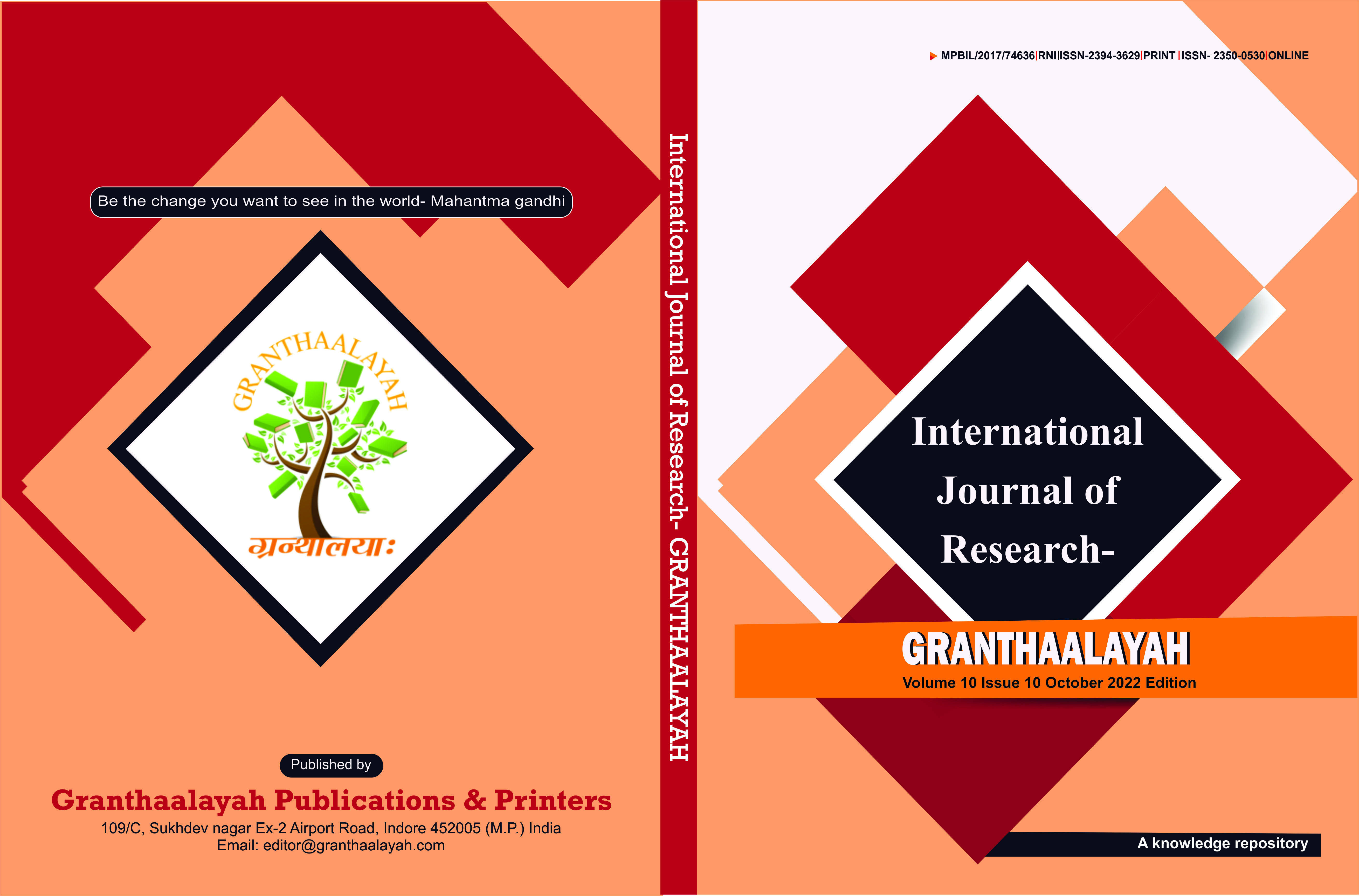CHARACTERISTIC OF POLY LACTID ACID (PLA)/ COIR WITH ADDITION OF CHITOSAN VARIATIONS FOR REVIEWING PLASTIC MATERIALS
DOI:
https://doi.org/10.29121/granthaalayah.v10.i10.2022.4832Keywords:
Poly Lactid Acid, Coir, Chitosan, PolymersAbstract [English]
Poly lactic acid or poly lactide (PLA) is a natural polymer that is biodegradable, thermoplastic and is an aliphatic polyester made from renewable materials such as young kepok banana starch. Poly lactic acid with the chemical formula CH3CH(OH)COOH is a biodegradable polymer obtained from the combination of lactic acid monomers. Therefore, in this study the PLA polymer as a matrix was added with fillers in the form of Coir and Chitosan. Coir is a coconut fiber that has been widely used by researchers for decades. Chitosan has been widely used as an important and promising biopolymer material in tissue engineering because of its anti-microbial activity, biodegradability, biocompatibility, and non-toxicity. The characteristics resulting from the combination of these three materials resulted in 4 samples, namely the fixed variable PLA with variations of Coir and Chitosan. Sample 1 Coir/Chitosan ( 90:10 (%)) produces a tensile strength value of 80 MPa. Sample 2 Coir/Chitosan (80:20 (%)) yielded a tensile strength of 55 MPa. Samples of 3 Coir/Chitosan (70:80 (%)) yielded a tensile strength of 48 MPa. Samples of 4 Coir/Chitosan (60:40 (%)) produced a tensile strength of 30 MPa. The FTIR test on sample 1 resulted in a new compound found in the PLA/Coir/Chitosan composite, namely the compound N=C=O which is an isocyanate group at the peak of the 2279.86 cm-1 group. While the SEM test which shows the physical structure of the sample composition of PLA with the addition of Coir/Chitosan (90:10%) is the sample with the best morphology.
Downloads
References
Agüero, A., Garcia-Sanoguera, D., Lascano, D., Rojas-Lema, S., Ivorra-Martinez, J., Fenollar, O., and Torres-Giner, S. (2020). Evaluation of Different Compatibilization Strategies To Improve The Performance of Injection-Molded Green Composite Pieces Made of Polylactide Reinforced With Short Flaxseed Fibers. Polymers, 12-821. https://doi.org/10.3390/polym12040821. DOI: https://doi.org/10.3390/polym12040821
Devi, B. C., Febriansyah, B. A., Nurkhamidah, S. and Rahmawa, Y. (2019). Studi Pemilihan Proses Pabrik Poly-L-Lactic Acid (PLLA) Dari Tetes Tebu. 8(2). https://doi.org/10.12962/j23373539.v8i2.46456. DOI: https://doi.org/10.12962/j23373539.v8i2.46456
Bifel, R. D. N., Maliwemu, E.U.K., and Adoe, D.G.H. (2015). Pengaruh Perlakuan Alkali Serat Sabut Kelapa terhadap Kekuatan Tarik Komposit Polyester. LJTMU. 02(01), 61-68.
Christiani Evi, S. (2008). Karakterisasi Ijuk Pada Papan Komposit Ijuk Serat Pendek Sebagai Perisai Radiasi Neutron. Thesis. Universitas Sumatra Utara.
Gokila, S., Gomathi, T., Vijayalakshmi, K., Alsharani, F.A., Sukumaran, A and Sudha, P.N. (2018). Development of 3D Scaffolds Using Nanochitosan/SilkFibroin/ Hyaluronic Acid Biomaterials For Tissue Engineering Applications. International Journal of Biological Macromolecules, 120. 876-885. https://doi.org/10.1016/j.ijbiomac.2018.08.149. DOI: https://doi.org/10.1016/j.ijbiomac.2018.08.149
Kasim, A. N., Selamat, M. Z, Daud, M. A. M., Yaakob, M. Y., Putra, A., and Sivakumar, D. (2016). Mechanical Properties of Polypropylene Composites Reinfprced with Alkaline Treated Pineapple Leaf Fibre from Josapine Cultivar. International Journal of Automative and Mechanical Engineering, 13, 3157-3167. https://doi.org/10.15282/ijame.13.1.2016.3.0263. DOI: https://doi.org/10.15282/ijame.13.1.2016.3.0263
Rajesh, M., Pitchaimani Jeyara., and Rajini, N. (2016). Free Vibration Characteristics of Banana/Sisal Natural Fibers Reinforced Hybrid Polymer Composite Beam. Procedia Engineering. 144. 1055 - 1059. https://doi.org/10.1016/j.proeng.2016.05.056. DOI: https://doi.org/10.1016/j.proeng.2016.05.056
Manalo, A. C., Wani, E., Zukarnain, A. N., and Karunasena, W., Lau, T. K. (2015). Effects of Alkali Treatment And Elevated Temperature on The Mechanical Properties of Bamboo Fibre Polyester Composites. Composites Part. 80, 73-83. https://doi.org/10.1016/j.compositesb.2015.05.033. DOI: https://doi.org/10.1016/j.compositesb.2015.05.033
Oerbandono, T., Gunawan, A. A., and Sulistyo, E. (2015). Karakteristik Kekuatan Bending Dan Impact Akibat Variasi Unidirectional Pre-Loading Pada Serat Penguat Komposit Polyester. Proceeding Seminar Nasional Tahunan Teknik Mesin XIV (SNTTM XIV). Banjarmasin.
Ramesh. M., Palanikumar. K., and Reddy, H. K., (2013). Mechanical Property Evaluation of Sisal-Jute-Glass Fiber Reinforced Polyester Composites. Composites : Part B. 48. 1-9. https://doi.org/10.1016/j.compositesb.2012.12.004. DOI: https://doi.org/10.1016/j.compositesb.2012.12.004
Ridwan, Wirjosentono, B., Tamrin, Siburian, R., Rihayat, T., and Nurhanifa. (2018). Modification of PLA/PCL/Aceh's bentonite nanocomposites as biomedical materials. AIP Conference Proceedings, 2049(1), 02008. https://doi.org/10.1063/1.5082413. DOI: https://doi.org/10.1063/1.5082413
Romels, C. A. L., Soenoko, R., and Wahyudi, S. (2011). Komposit Hibrid Polyester Berpenguat Serbuk Batang dan Serat Sabut Kelapa. Jurnal Rekayasa Mesin. 2(2), 145-153.
Sanjay, M. R., and Yogesha, B. (2017). Studies on Natural/Glass Fiber Reinforced Polymer Hybrid Composites : An Evolution. Materials Today : Proceedings. 4, 2739-2747. https://doi.org/10.1016/j.matpr.2017.02.151. DOI: https://doi.org/10.1016/j.matpr.2017.02.151
Shrivastava, R., Telang A., Rana. R. S. and Purohit, R. (2017). Mechanical Properties of Coir/ G Lass Fiber Epoxy Resin Hybrid Composite. Materials Today: Proceedings. 4, 3477-3483. https://doi.org/10.1016/j.matpr.2017.02.237. DOI: https://doi.org/10.1016/j.matpr.2017.02.237
Siakeng, R., Jawaid, M., Ariffin, H., and Sapuan, S.M., (2019). Mechanical, Dynamic, and Thermomechanical Properties of Coir/Pineapple Leaf Fiber Reinforced Polylactic Acid Hybrid Biocomposites. Polym. Compos. 40, 2000-2011. https://doi.org/10.1002/pc.24978. DOI: https://doi.org/10.1002/pc.24978
Sim, K.J., Han, S.O., and Seo, Y.B. (2010). Dynamic Mechanical And Thermal Properties of Red Algae Fiber Reinforced Poly (Lactic Acid) Biocomposites. Macromol. 18, 489-495. https://doi.org/10.1007/s13233-010-0503-3. DOI: https://doi.org/10.1007/s13233-010-0503-3
Sinaga, R.F., Ginting, G.M., Ginting, M.H., and Hasibuan, R. (2014). Pengaruh Penambahan Gliserol Terhadap Sifat Kekuatan Tarik dan Pemanjangan Saat Putus Bioplastik dari Pati Ubi Talas. Jurnal Teknik Kimia USU 3(2), 19-24. https://doi.org/10.32734/jtk.v3i2.1608. DOI: https://doi.org/10.32734/jtk.v3i2.1608
Singh, J. I. P., Singh, S., and Dhawan, V. (2020). Influence of Fiber Volume Fraction and Curing Temperature on Mechanical Properties of Jute/PLA Green Composites. Polymers and Polym. Compos. 28, 273-284. https://doi.org/10.1177/0967391119872875. DOI: https://doi.org/10.1177/0967391119872875
Spiridon, I., Darie, R.N., and Kangas, H. (2016). Influence of Fiber Modifications on PLA/Fiber Composites. Behavior To Accelerated Weathering. Composites, 92, 19-27. https://doi.org/10.1016/j.compositesb.2016.02.032. DOI: https://doi.org/10.1016/j.compositesb.2016.02.032
Sujaritjun, W., Uawongsuwan, P., Pivsa-Art, W., and Hamada, H. (2013). Mechanical Property of Surface Modified Natural Fiber Reinforced PLA Biocomposites. Energy Procedia. 34, 664-672. https://doi.org/10.1016/j.egypro.2013.06.798. DOI: https://doi.org/10.1016/j.egypro.2013.06.798
Suryani, Agusnar, H., Wirjosentono, B., Rihayat, T. and Nurhanifa (2018). Thermal Degradation of Aceh's Bentonite Reinforced Poly Lactic Acid (PLA) Based on Renewable Resources For Packaging Application. AIP Conference Proceedings, 2049, 020040. https://doi.org/10.1063/1.5082445. DOI: https://doi.org/10.1063/1.5082445
Syamani, F.A., Kurniawan, Y.D., and Suryanegara, L. (2014). Cellulose Fibers from Oil Palm Fronds Reinforced Polylactic Acid Composite. Proceeding of the ASEAN Conference on Science and Technology, 1-5.
Rihayat, T., Suryani, Satriananda, Ridwan, Nurhanifa, Putra, A., Audina, N., Yunus, M., Sariadi, Safari, Jalal, R., Khan, N. S. P., Saifuddin. (2018). Influence of coating polyurethane with mixture of bentonite and chitosan nanocomposites. AIP Conference Proceedings, 2049(1), 020020. https://doi.org/10.1063/1.5082425. DOI: https://doi.org/10.1063/1.5082425
Yashwanth, M. K., Easwara Prasad, G. L., and Akshay, N. K. (2016). Comparative Study on Properties of Coir and Sisal Fibre Reinforced Composites. International Journal of Inovative Research in Science, Engineering and Technology. 5(9), 992-926.
Yusof, Y., Mat Nawi, B. N., and Alias, B. M. S. H. (2016). Pineapple Leaf Fiber and Pineapple Peduncle Fiber Analyzing and Characterization for Yarn Production. ARPN Journal of Engineering and Applied Sciences. 11(6), 4197-4202.
Yusoff, B. R., Takagi, H., and Nakagaito, A. N. (2016). Tensile and Flexural Properties of Polylactic Acid-Base Hybrid Green Composites Renforced by Kenaf, Bamboo and Coir Fibers. Industrial Crops and Product. 94, 562-573. https://doi.org/10.1016/j.indcrop.2016.09.017. DOI: https://doi.org/10.1016/j.indcrop.2016.09.017
Zakikhani, P., Zahari, R., Sultan, M. T. H., and Majid. D. I (2014). Extraction and Preparation of Bamboo Fibre Reinforced Composites. Materials and Design. 63, 820-828. https://doi.org/10.1016/j.matdes.2014.06.058. DOI: https://doi.org/10.1016/j.matdes.2014.06.058
Zhang, J., Khatibi, A. A., Castanet, E., Baum, T., Komeily-Nia, Z., Vroman, P., and Wang, X., (2019). Effect of Natural Fibre Reinforcement on The Sound and Vibration Damping Properties of Bio-Composites Compression Moulded By Nonwoven Mats. Compos. Commun. 13, 12-17. https://doi.org/10.1016/j.coco.2019.02.002. DOI: https://doi.org/10.1016/j.coco.2019.02.002
Zhang, L., Li, Z., Pan, Y.T., Y'anez, ˜ A.P., Hu, S., Zhang, X.Q., Wang, R., and Wang, D.Y. (2018). Polydopamine Induced Natural Fiber Surface Functionalization : A Way Towards Flame Retardancy of Flax/Poly (Lactic Acid) Biocomposites. Composites, Part 154, 56-63. https://doi.org/10.1016/j.compositesb.2018.07.037. DOI: https://doi.org/10.1016/j.compositesb.2018.07.037
Published
How to Cite
Issue
Section
License
Copyright (c) 2022 Ridwan, Teuku Rihayat, Adi Saputra Ismy, Awanis Ilmi, Nurhanifa Aidy, Atiqah Aida

This work is licensed under a Creative Commons Attribution 4.0 International License.
With the licence CC-BY, authors retain the copyright, allowing anyone to download, reuse, re-print, modify, distribute, and/or copy their contribution. The work must be properly attributed to its author.
It is not necessary to ask for further permission from the author or journal board.
This journal provides immediate open access to its content on the principle that making research freely available to the public supports a greater global exchange of knowledge.

























